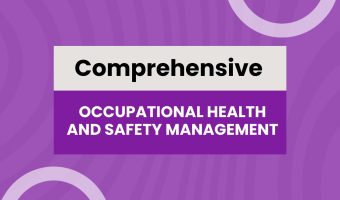Comprehensive Occupational Health and Safety Management
About This Course
This program develops knowledge and practical skills in identifying, assessing, and mitigating occupational health and safety risks in diverse organizational settings. It covers both strategic and technical dimensions of OHS, enabling professionals to design, implement, and manage effective OHS systems that protect workers and align with legal and organizational policies.
Learning Objectives
Understand the principles, importance, and frameworks of occupational health and safety management, including ISO 45001 and national OHS regulations.
Identify workplace hazards and assess risks using standard tools such as risk matrices and Job Safety Analysis (JSA).
Develop and implement workplace OHS policies and safety systems aligned with legal and organizational needs.
Apply safety practices and enforce the use of Personal Protective Equipment (PPE) in a variety of occupational settings.
Investigate workplace incidents, determine root causes, and recommend corrective actions.
Promote workplace hygiene, mental wellness, and occupational health protocols.
Foster a proactive safety culture through behavior-based safety (BBS) programs and staff engagement.
Ensure compliance with OHS laws and prepare for audits and inspections.
Present and defend a comprehensive OHS improvement plan for a simulated or real organization during the capstone project.
Target Audience
- Safety officers, HR personnel, supervisors, project managers, factory workers, government inspectors, NGO/logistics staff
Curriculum
78h
Module 1: Introduction to Occupational Health and Safety
This foundational module introduces participants to the principles and significance of occupational health and safety. It covers the evolution of safety practices, types of workplace hazards, roles of stakeholders, and the global and national frameworks (including ILO conventions and ISO 45001) guiding OHS practices.
Module 2: Hazard Identification and Risk Assessment
Participants will learn how to systematically identify workplace hazards and assess associated risks. This module equips learners with practical tools such as risk matrices and Job Safety Analysis (JSA) to ensure early detection and mitigation of safety threats across work environments.
Module 3: OHS Policies and Management Systems
This module focuses on designing and implementing OHS policies that reflect legal obligations and organizational priorities. Participants will explore elements of a robust OHS management system (OHSMS) and learn to align safety protocols with ISO 45001 standards and internal governance structures.
Module 4: Workplace Safety Practices and PPE
Focusing on daily safety practices, this module provides practical training on proper use of Personal Protective Equipment (PPE), safety signage, fire prevention, and emergency response procedures. It emphasizes safety culture at the operational level and behavioral compliance.
Module 5: Incident Investigation and Reporting
Participants will develop skills to investigate workplace incidents using structured techniques such as Root Cause Analysis. The module emphasizes timely reporting, accurate documentation, and the implementation of corrective actions to prevent recurrence and improve organizational learning.
Module 6: Health and Hygiene in the Workplace
This module explores occupational health risks, hygiene practices, and workplace wellness. Topics include occupational diseases, mental health, stress management, substance abuse, and workplace sanitation, ensuring participants understand how to promote both physical and psychological safety.
Module 7: Safety Culture and Behavior-Based Safety
Participants will explore how to foster a proactive safety culture where employees take ownership of safe behavior. The module includes models of behavior-based safety (BBS), motivational strategies, and effective communication tools like safety talks and toolbox meetings.
Module 8: Ergonomics and Workplace Design
This module addresses the science of ergonomics and its application in reducing injuries caused by poor workplace design. Participants will assess physical workspaces, explore ergonomic risk factors, and recommend layout improvements for offices, factories, and mobile work settings.
Module 9: OHS Legal and Regulatory Compliance
Participants will examine the legal requirements for occupational safety in Liberia and international standards such as OSHA. The module covers regulatory roles, inspection readiness, documentation, penalties, and how to manage compliance audits effectively.
Module 10: Capstone Project and Practical Demonstration
In this final module, participants will apply all previous knowledge by designing a complete OHS management plan or conducting a simulated workplace inspection. They will present their findings and safety improvement proposals to peers and instructors for evaluation and feedback.





